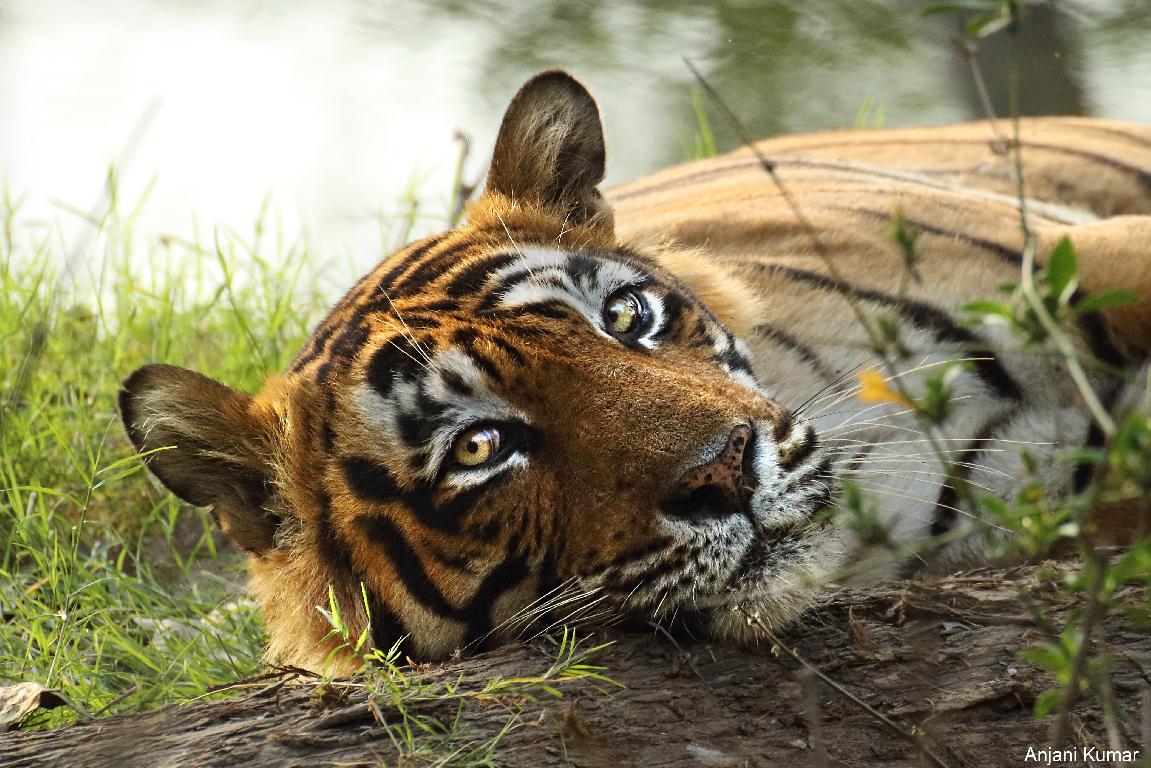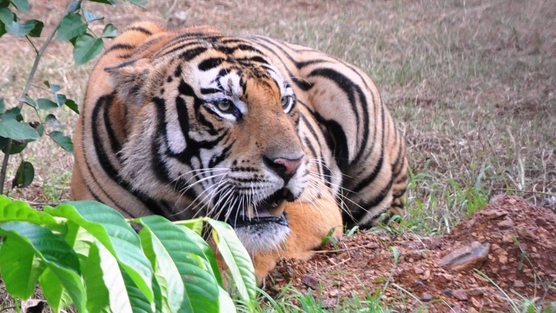USTAD’S chances in the wild, if released back (Part 1)
Few pertinent questions that have been raised by some people on different forums, related to Ustad’s freedom:
1. Can Ustad survive on his own, if he is released back in the wild?
2. Is it likely that Ustad may have forgotten his hunting skills since he has been put into captivity for so long?
3. Will it be a security threat for him from the department itself, since some of them are primarily against Ustad and behind its shifting to a zoo?

USTAD in a leisure mood in the wild, Ranthambore National Park, Photo By: Anjani Kumar
Certainly the questions are coming to our minds because we know so little or almost nothing about tigers and their conservation programs in different parts of India. Recent history of Indian tiger conservation program suggests both success and failure of such experiments on wild tigers ‘capture and releasing back’ incidents.
Now, don’t draw the conclusion that ‘ITS ALL CONFUSING’! The history if studied thoroughly on case to case basis, can clarify that the success and failure lies on both the tiger as well as the department’s preparations. And each case is unique to the scenarios of that particular case.
Let us look at the last 6-7 years history for such experiments and try to study all the scenarios in order to understand Ustad’s (and for that reason all such tigers’) chances in the wild if released back.
A. Types of tigers that were captured from the wild and then released back after some interval:
1. Problem tigers (tigers who have attacked/killed/consumed humans/cattle), captured and released back in the wild.
2. Injured tigers, captured and then released back in the wild after treatment.
3. Abandoned and/or orphan cubs captured, hand raised, and then released back in the wild.
B. Types of releasing procedure that were followed for such experiments:
1. Tigers released within the same location from where they were captured.
2. Tigers released in the same reserve but at a different location deep inside the forests, far from where they were captured.
3. Tigers released in different reserves other than the reserve from where they were captured.
C. Types of captive conditions:
1. Small iron or walled cage, processed cow/buffalo/pig/goat/chicken meat, feeding as per zoo routine.
2. Walled open area in a zoo spread over few sq. ft. (larger than 1), processed cow/buffalo/pig meat, feeding as per zoo routine.
3. Walled open area in a zoo spread over few sq. ft. (larger than 1), initially processed cow/buffalo/pig meat & feeding as per zoo routine and later live cow/buffalo/pig/goat meat & feeding as per tigers own routine.
4. Larger open area in a zoo/biological park spread over few acres, live cow/buffalo/pig/goat meat, feeding as per tigers own routine.
5. Large open enclosures within the natural habitat of a tiger reserve, live wild bait, feeding as per tigers own routine.
D. Captivity duration:
1. 0-30 days
2. 30-90 days
3. 90-180 days
4. > 6 months and < 18 months
5. >18 months and < 3 years
6. >3 years and < 6 years
E. Types of reasons that the tiger became a problem tiger:
1. Injury (external/internal) leading the tiger to search for easy prey like humans/cattle.
2. Old age leading the tiger to search for easy prey.
3. Diseases leading the tiger to search for easy prey.
4. The tiger was habituated with easy prey through learning from its parent tiger during its cub/sub-adult stage (in case the parent tiger had any of the problems as mentioned in 1, 2, and/or 3).
5. Stiff competition with other tigers in the forest area leading he tiger to roam around in the buffer area and prey on humans/cattle.
6. The tiger became orphan or was abandoned before it could learn chasing and hunting (‘chasing & hunting’ vs ‘hunting’ are different in case of big cats) on its own.
Continued..
Case History 1: Tiger released in Sundarbans after 11 months of treatment:
June 29, 2013
A tiger was released in the Sundarbans on June 29, 2013, 11 months after he was captured from the jungle due to an injury. The tiger was tranquilised on July 26, 2012 from Pirkhali forest and since then the animal was under treatment at the Alipur zoo hospital in Kolkata.
The big cat had often been found lying on the bank of a river triggering suspicion among forest department personnel that the tiger was not well. It was found after tranquilising the animal, that he had a serious wound in one of his hind legs.
The tiger was taken to the zoo hospital but was not exhibited. After being declared fit by the veterinarians there, the tiger was released in Panchamukhani forest in the Sundarbans.
http://www.business-standard.com/article/pti-stories/tiger-released-in-sundarbans-after-11-months-of-treatment-113062900581_1.html
Some Other Unfortunate Victims:
Nandan, captured by Nandankanan Zoo authorities, Bhubaneswar as he entered into the zoo peripherry on April 30, 2013. He was simply ordered to be kept in the zoo on a permanent basis by the NTCA because of inordinate delay from the state and central bureaucrats and the interest of the zoo in its captive breeding programme for developing wild gene pool.

NANDAN, a 6 year old male tiger, serving his life-time imprisonment at Nandankanan Zoo, Bhubaneswar for daring to enter the zoo periphery when he was about 5 years old. His other fault was, ‘HE WAS NOT A CELEBRITY LIKE USTAD’.

I think Ustad’s rewilding will be a process that will need time. He is in captivity at a tiny area for more than 4 months now and during this time, he has lost a lot of his muscular power which he needs for hunting prey.
Well Manuela, thank you for leaving a comment on the post. I would like you to wait for the remaining parts of the same post thread in order to understand what really needs to be done for Ustad and for that reason any other tiger under similar conditions.